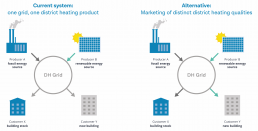The role of GOs for heating and cooling in the heat transition (Energy Sources Report E3)
In the supply of heating or cooling via grids, the question arises as to how the attributes of climate-neutral energy generated by specific plants can be assigned to individual consumers. Currently, ecological quality indicators of district heating and cooling (H&C), such as RE and waste heat shares, primary energy factors (PEF) and emission factors (EF) are usually determined for each individual grid. The grid averages, which are reported to all connected customers, take into account the characteristics of all plants that feed into the grid.
Yet similarly to grid-connected electricity generation, there is interest from customers to purchase a green heating or cooling product with a 100% share of climate-neutral thermal energy. This option is relevant when choosing between connecting to a district heating or cooling grid and an alternative, decentralised source of energy. Also, a 100% climate-neutral energy product might fetch a green price premium, which can provide a demand-side impulse to decarbonise the grid – especially if green district H&C marketing focuses on new plants. Besides intrinsically motivated private customers, this is a relevant perspective for commercial customers, many of whom must implement their own climate neutrality strategies. When purchasing energy that is supplied via grids which are not yet fully decarbonised, switching to green energy products can be a necessary component of implementing such strategies. The option to supply their tenants with climate-neutral district heating is also important for commercial or municipal landlords. Finally, developers and building owners faced with regulatory requirements on buildings’ emissions or renewable energy use may wish to support the expansion of climate-neutral generation sources in their heating or cooling grids. However, this use case presupposes that legislation provides a role for green district H&C products as an option for complying with regulatory requirements for buildings or being eligible for subsidies.
The prerequisite for all these applications is the existence of a verification procedure that enables a clear allocation of green energy attributes to customers and, in combination with disclosure rules, excludes multiple marketing of such attributes. Given that the second Renewable Energy Directive requires the establishment of guarantees of origin (GO) systems also for heating and cooling from renewable energy sources, such a verification procedure will be available in the future. As a basis for a transparent marketing of green thermal energy products, H&C GOs could become a building block in the toolbox of the heat transition.
Against this background, the aim of this report is to provide an overview of the relevant framework conditions, potential applications and special features of verification with H&C GOs and to discuss resulting implications for H&C GO systems.
Disclosure and marketing options for district heating (Source: Hamburg Institut)


